Polaris icebreaker
Polaris icebreaker current position
Polaris icebreaker current location is at Baltic Sea (coordinates 65.44424 N / 24.22966 E) cruising en route to ICEBREAKING CH 72. The AIS position was reported 2 minutes ago.
Current PositionSpecifications of Polaris icebreaker
| Year of build | 2016 / Age: 8 |
| Flag state | Finland |
| Builder | Arctech Helsinki Shipyard (Helsinki, Finland) |
| Class | Aker Arctic ARC130 (Icebreaking Support Vessel) |
| Building cost | EUR 220 million (USD 260 million) |
| Engines (power) | Wartsila (22.5 MW / 30173 hp) |
| Propulsion power | 19 MW / 25479 hp |
| Speed | 17 kn / 31 km/h / 20 mph |
| Length (LOA) | 110 m / 361 ft |
| Beam (width) | 24 m / 79 ft |
| Gross Tonnage | 10000 gt |
| Crew | 16 |
| Beds | 24 |
| Decks | 6 |
| Decks with cabins | 2 |
| Owner | Arctia Oy |
| Operator | Arctia Offshore Oy |
Polaris icebreaker Review
Review of Polaris icebreaker
Polaris is a Finnish icebreaking vessel owned and operated by Arctia Ltd (a Finnish state-owned company). One of Finland's icebreaker ships, Polaris is the most powerful Finnish icebreaker ever constructed, as well as the world's first LNG-powered icebreaker.
The vessel (IMO number 9734161) is currently Finland-flagged (MMSI 230661000) and registered in Helsinki.
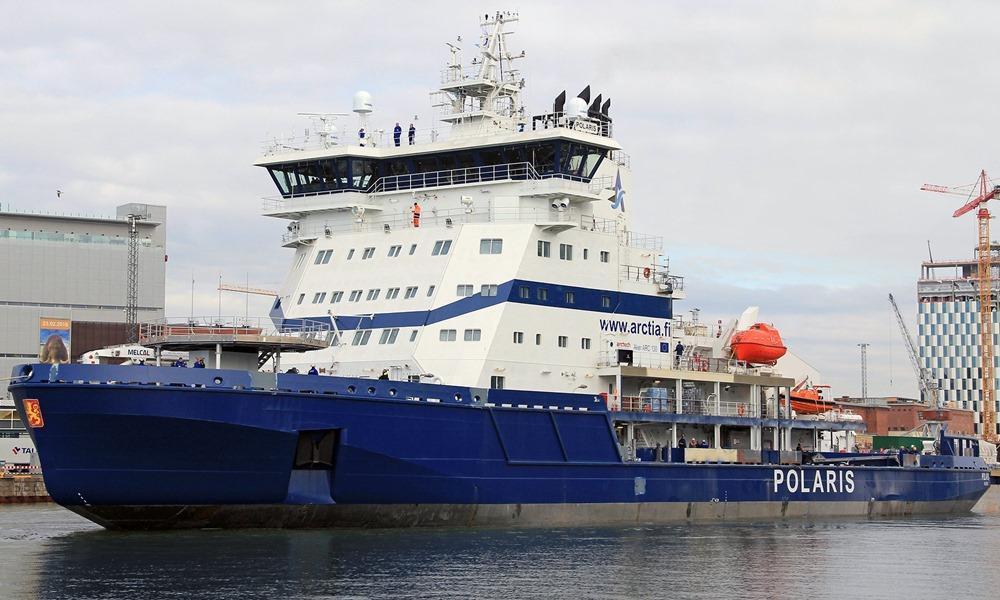
This is the world's first icebreaker equipped with dual-fuel engines. It runs on both LSMDO ("low-sulfur marine diesel oil") and LNG ("liquefied natural gas"), which lowers both emissions and operating costs.
Vessel's technical requirements and specifications were published in February 2013. Among those was the 16, 2 MW quad-screw engine - allowing navigation through compressive ridge fields at an average escort speed 9-11 Kkn (17-20 kph / 10-13 mph).
The ship's bollard pull (zero speed pulling capability) and propulsion are sufficient to allow a year-round operation even during winter months (ice thickness requirement 1,8 m / 6 ft). Among the specifications was also a maneuverability requirement - an ability for a 180-degree turn within a length of 220 m (520 ft) in just 3 minutes.
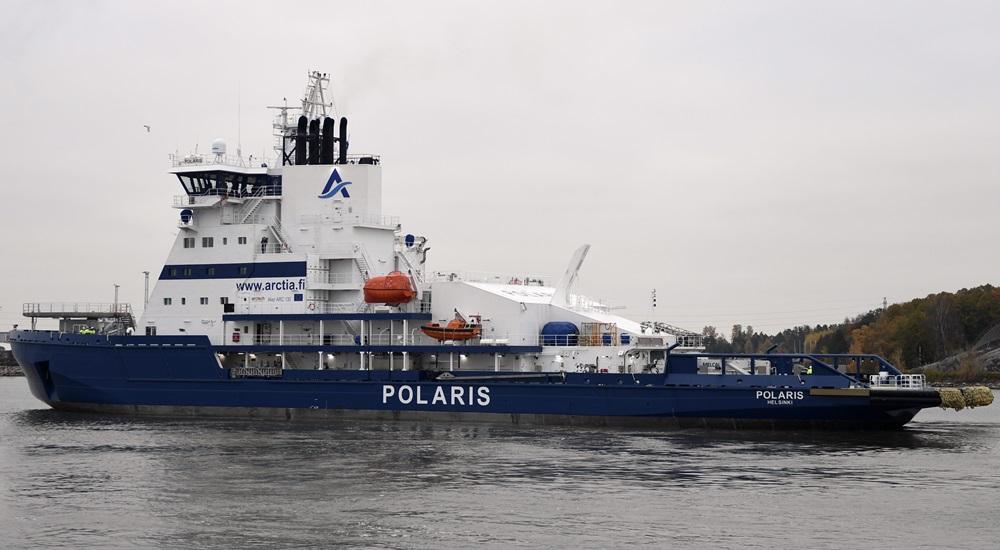
Designed primarily for Baltic Sea icebreaking and assisting services, the new Polaris icebreaker is also used in oil spill response operations due to the increasing oil shipping traffic in Baltic Sea the whole year-round. For this secondary purpose, the ship is fitted with special equipment for operations in both ice and open water and also for open-sea towing operations in strong wind and wave conditions.
Polaris vessel details and technology
The shipbuilder Arctech Helsinki Shipyard company was founded in 2011 and specializes in building icebreakers and other ice-going (mainly platform-supply and rescue) vessels. The company is a joint venture between STX Finland Cruise (now Meyer Turku Oy) and USC (United Shipbuilding Corporation, Russia). USC purchased 50% of Hietalahti Shipyard (aka Helsinki New Shipyard) in late 2010. In December 2014, USC bought the other 50% from STX Europe (now Chantiers de l'Atlantique) thus becoming the sole owner of the shipyard.
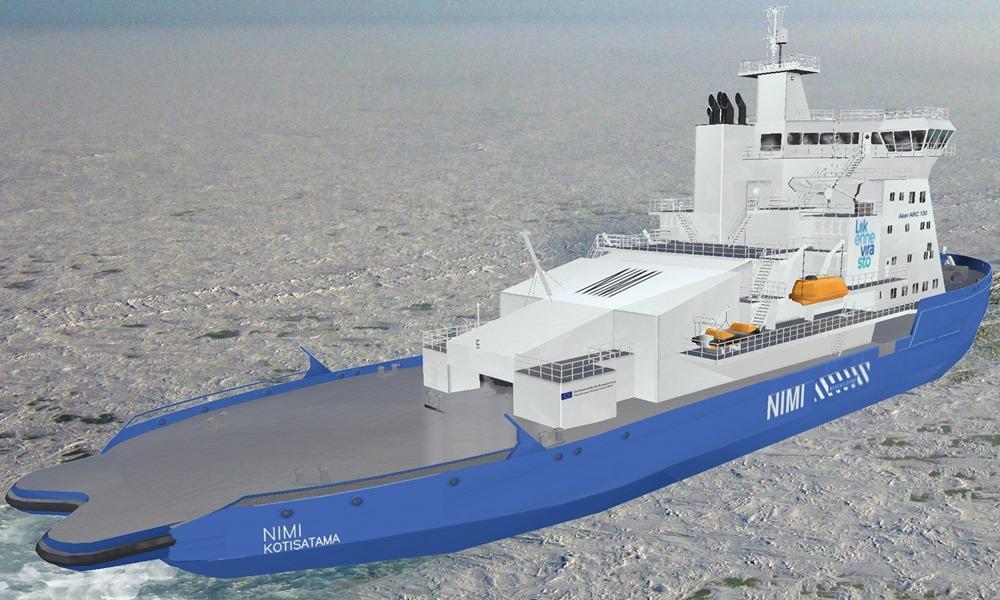
Instead of a helipad, the ship has a small bow-located winching area that can be used for helicopter landing in cases of emergency.
The vessel is PC4/Polar Class 4 intended for year-round operations in thick first-year ice. The class also signifies the ship can be operated as an escort ice-breaker in difficult ice conditions.
The hull features structural strengthening in several critical areas.
As an oil spill response ship, Polaris has an installed advancing system and also stern-mounted brush skimmers and recovery tanks (total capacity 1300 m3 / 46000 ft3).
The powerplant is positioned midship (main deck level), consisting of all four (2 pairs) Wartsila four-stroke dual-fuel generator sets (medium-speed engines) fitted with exhaust gas economizers. An auxiliary engine is used for producing electricity when the vessel is at the port. The electrical power plant's combined output is 22,5 MW. The ship also has an additional emergency diesel generator.
Polaris is capable to open a uniform ice-free channel 25 m (82 ft) wide through ice field with thickness 1,8 (6 ft) at 4 Kn speed (7,4 kph / 4,6 mph). The icebreaker can also maintain 9,2 Kn (17 kph / 11 mph) speed in unbroken ice fields with thickness 0,9 m (3 ft). These specifications allow the ship to maintain a high escort speed in winter ice conditions.
The Polaris icebreaker's projected lifetime (service life) is 50 years.
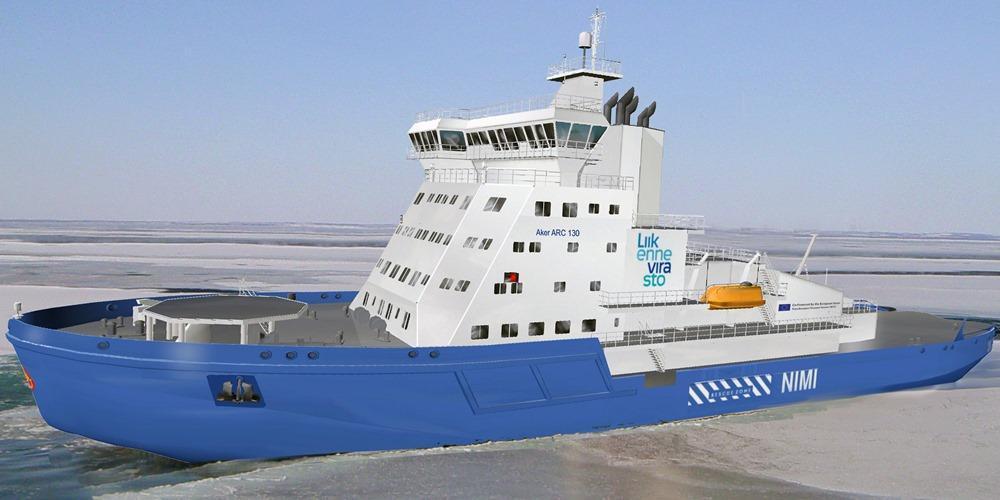
The list of other Finnish icebreakers also includes (in brackets - year built): MSV Fennica (1993), MSV Nordica (1994), Kontio (1987), Otso (1986), Sampo (1960), Sisu (1976), Urho (1975).
In late November 2014, Finland's "Cabinet Committee on Economic Policy" released an official statement regarding the country's aging icebreaking fleet. According to the statement, Arctia Shipping's old fleet would be fully replaced with new icebreakers by the year 2029. The project's overall cost is approx EURO 1 billion. The new vessels (like Polaris) must be multipurpose icebreakers (including for Arctic oil explorations).
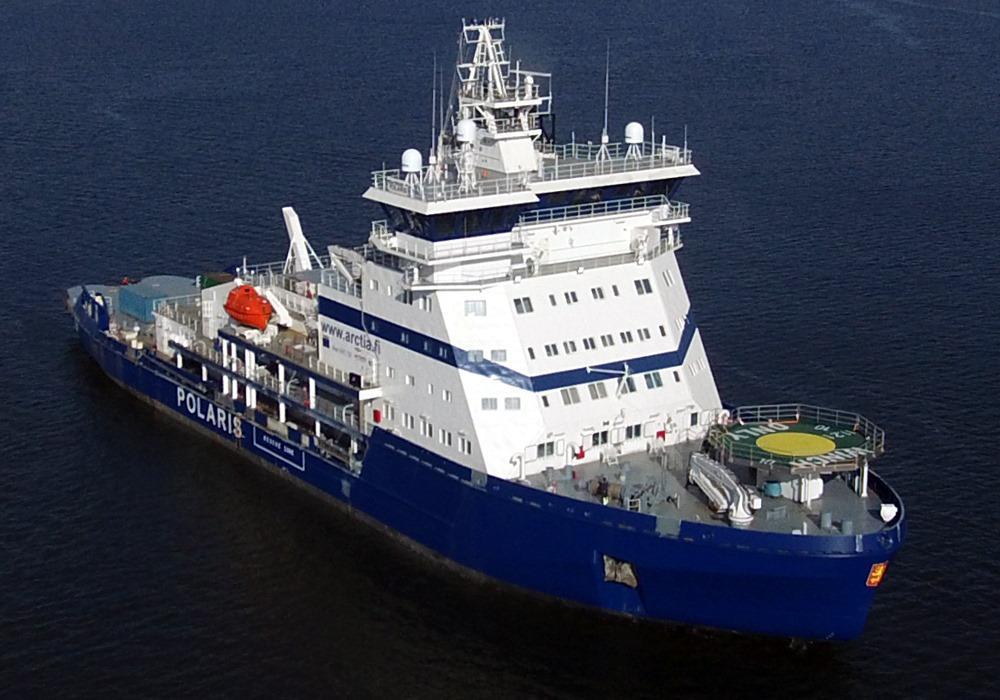
- The vessel has 1 dining room, Sauna, no swimming pool, no elevator, no helipad (helicopter deck).
- Max Draught: 9 m (30 ft)
- DWT Deadweight tonnage: 3000 tons
- Displacement tonnage: 5880 tons
- Bollard pull (emergency towing capacity) 193 tons
- Ice-breaking capacity: 1,2 m (4 ft) at speed 6 kn / 7 mph / 11 kph
- Ice-breaking capacity: 1,8 m (4 ft) at speed 3,5 kn / 4 mph / 6,5 kph
- Endurance: 10 days (LNG), 20 days (LSMDO)
- Powerplant: 2x Wartsila 9L34DF diesel engines (each 4,5 MW power output), 2x Wartsila 12V34DF diesel engines (each 6 MW output), 1x Wartsila 8L20DF (auxiliary engine, 1,4 MW output)
- Propulsion: Diesel-electric, 3x azimuth thrusters (ABB Azipod motors), power outputs - 1x bow (6 MW), 2x stern (each 6,5 MW), no pitch propellers. Total propulsion power output is 19 MW (25000 hp).
- The vessel's building cost is ~USD 260 million. For comparison, the Canadian and US Coast Guard icebreakers cost ~USD 1,2 billion per vessel.
Note: In the case of poor AIS coverage, tracking the vessel's current location will be impossible. You can see CruiseMapper's list of all icebreakers and ice-breaking research ships in the "itinerary" section of our Icebreakers hub. All states and their fleets are listed there.
Polaris icebreaker - user reviews and comments
Other Arctia Finland cruise ships
Polaris icebreaker Wiki
On February 4, 2019, the icebreaker Polaris completed its first LNG bunkering at Tornio Manga LNG terminal in Tornio (Finland). The vessel is the most powerful Finland-flagged icebreaker and the world's first with dual-fuel engines using both ULSD and LNG (low-sulfur marine diesel and liquefied natural gas).
The icebreaker's namesakes are the riverboat Travelmarvel Polaris (2021) and the cruiseferry Havila Polaris (2022) and the expedition ship Viking Polaris (2022).
The shipowner Arctia Oy is a state-owned company operating Finland's icebreaker fleet. The company was established in 2010 as "Arctia Shipping Oy" and was renamed in 2016 to "Arctia Oy". Arctia Ltd serves Liikennevirasto ("Finnish Transport Agency" / abbrev FTA) during winter months. This is a Finnish government agency (annual budget EUR 1,6 billion) that maintenance all the Finland's roads, railways, and waterways.
Arctia Ltd also charters the icebreaking vessels to private companies developing offshore gas-oil fields and wind farms.
Arctia Ltd has 4 subsidiaries:
- Arctia Icebreaking (managing the conventional / older icebreakers Voima, Sisu, Urho)
- Arctia Offshore (managing the multipurpose icebreakers Nordica, Fennica, Otso, and the newest - the LNG-powered Polaris)
- Arctia Karhu (managing the port icebreaking/harboring and towing service in the Gulf of Bothnia with the vessel Ahto)
- Arctia Management Services (manages the oil-recovery icebreaker Kontio)
- If necessary, all Arctia icebreakers can be equipped with oil spillage equipment.
Company's icebreaker base is at Katajanokka (Helsinki, Finland).
An upgraded (enlarged and more powerful) version of Aker ARC130 design is ARC130A. Two such icebreakers (Alexander Sannikov and Andrey Vilkitsky) were delivered to Gazprom Neft (Russia) in 2018 to serve Gazprom's Arctic Gate (Novy Port offshore crude-oil loading terminal) of Novoportovskoye oil field.


